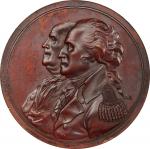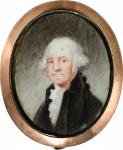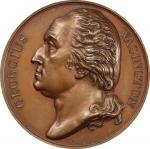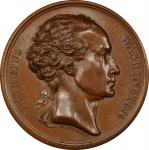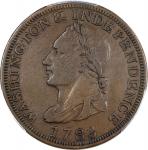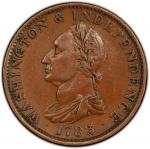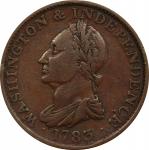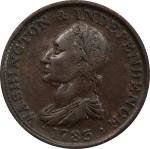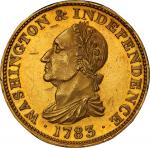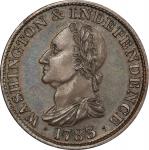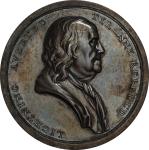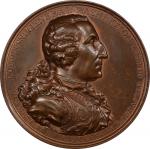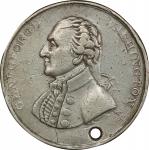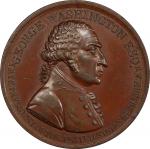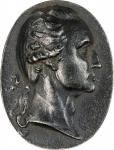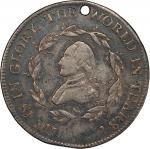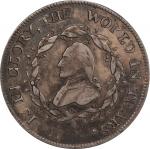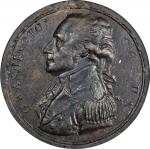Circa 1832 C.C.A.U.S.-Birth Centennial Medal. Musante GW-91. Baker-163F. White Metal. Genuine (PCGS). 40.2 mm. 286.3 grains. Heavy dark patina with considerable roughness not unlike fire scale, though in this case it is probably better attributed to aggressive pesting of the white metal composition. Though there is some variability in the degree of roughness across the obverse, the color is fairly consistent, and the design features are likewise of consistent sharpness, generally Extremely Fine, or so. The reverse is virtually identical, but seemingly a bit smoother. <p><p><p>The rarity, crude appearance, cheaper metal, and status as an obvious copy of the rare C.C.A.U.S. Sansom series die by Joseph Reich seems to have early on introduced some question as to the value of this piece, historical or otherwise. It first appeared for sale in the W. Elliot Woodward sale of the incredible Joseph Mickley cabinet in 1867, where Woodward (already the owner of the piece), commented that "this medal has been shown to many collectors, who all agree in pronouncing it unique; tin, bronzed, fine." It is clear that little was known about it, and what is perhaps most interesting about this description is the assertion that this is "bronzed." To our eyes, this is clearly a heavily oxidized white metal piece, but the pronouncement that it was bronzed seems to secure into the factual record that this piece was already heavily oxidized by 1867, likely having seen a good bit of age and careless handling before it entered Mickleys collection. Charles Bushnell added it to his cabinet for $30, where it remained until Lorin Parmelee bought the collection intact and elected to not retain this piece.<p><p><p>When the Chapman brothers sold the Bushnell cabinet (for Parmelee), they also called it tin, and bronzed, along with carrying forward the understanding that it was unique. The Chapmans bought this piece in the Bushnell sale and, within the year, offered it to T. Harrison Garrett for $15, who declined it. It is unknown why. The rough appearance could have sealed the decision, but it might have also been a lack of confidence and just too much mystery.<p><p><p>It next appeared in the Chapman brothers sale of the A. Galpin Collection, in May 1883, but the Chapmans may have still been the owners. It was described by them in their second attempt as "Tin. Bronzed. Very fine. This medal was made by casting from a model. No struck impression known. Unique…" This suggests that the cast nature of the piece was probably a central concern of potential buyers and they needed to address it head-on, perhaps after criticism. Two years later, they offered it again, this time as part of their own collection, in 1885. They commented that it was "cast in lead, bronzed. Made in 1832. <em>Unique</em>. Very Fine…," apparently still not understanding the oxidized surface, but seeing fit to point out this was made in 1832, even though no evidence was presented. <p><p><p>William Spohn Baker was aware of both the Mickley and Bushnell offerings. He also did not buy it and went so far as to avoid giving it its own catalog number in his 1885 <em>Medallic Portraits</em>. Apparently, he suspected it as little more than some type of forged curiosity, but he did mention it as the final paragraph of his introduction to the <em>Birth, Death and Centennial, 1832 </em>chapter.<p><p><p>The next appearance we are aware of was in the February 1926 sale of the William Havemeyer Collection, a cabinet with many nice Washington pieces, cataloged by Thomas Elder. Elder is the first to recognize this as simply "white metal," abandoning the thought it was bronzed. However, he references it as Baker-57, Sansoms famous C.C.A.U.S. rarity (in silver), so he also didnt quite get it right. <p><p><p>The most recent appearance was in 1997, when Joe Levine cataloged it for his Presidential Coin and Antique sale in May 1997. He once again cataloged this as bronzed, and there can be no mistake that it is the same specimen as it is clearly plated. He attempted to correct the erroneous provenance information by Rulau and Fuld and added a couple of entries. The entries given below after 1926, are repeated from the Presidential sale.<p><p><p>One undeniable consistency across all appearances is that no concrete information about this piece is known. This, after a century and a half, has remained largely unchanged. It is presumed that this was made as a one-off trinket in 1832, perhaps in the excitement leading up to the Civic Procession in Philadelphia. But who made it? <p><p><p>One circumstantial possibility lies with a bookseller, John Conrad, having had a hand in the matter. Conrad participated in distributing the original C.C.A.U.S. medals. He advertised in Philadelphia in late 1805 and early 1806, announcing that Sansoms C.C.A.U.S. had been prepared and that examples were available for examination in his bookshop at 30 Chestnut Street. He announced that he would accept orders until March 30, 1806, after which no more would be made. <p><p><p>John Conrads business seems to have included family. Just two years later, a C. & A. Conrad & Co. advertised as booksellers at the same address, with later mentions appearing as late as 1811. John Conrad seems to have met with some financial failure, as in the summer of 1812, his property was sold by Sheriffs Sale to pay creditors. He seems to have returned to business in a limited way as he advertised in 1815 the publishing of a record of the War of 1812, and then "cheap letter paper" in 1820. In 1831, a John Conrad had published and was selling <em>The Pennsylvania State Reports for 1831</em>. The circa 1805 John Conrad clearly took an interest in the C.C.A.U.S. medal and could well have had a mold made from one that later could have been used to cast a piece like this. This is all conjecture but might prove a useful starting point as more minutiae of American history continues to become digitized and easily searched. From the Sydney F. Martin Collection. Earlier ex Joseph J. Mickley; W. Elliot Woodward; W. Elliot Woodward’s sale of the Joseph J. Mickley Collection, October 1867, lot 2983 @ $30; Charles I. Bushnell; Lorin G. Parmelee; S.H. and H. Chapman’s sale of the Charles I. Bushnell Collection, June 1882, lot 1365 @ $10; S.H. and H. Chapman; S.H. and H. Chapman’s sale of the A. Galpin Collection, May 1883, lot 524 @ $10; S.H. and H. Chapman, May 1885, lot 660; Thomas Elder’s sale of the William F. Havemeyer Collection, February 1926:1562; Woodcliff Investment Corp. (William Anton, Jr.), 1970s; Stewart Witham; Presidential Coin and Antique’s sale of May 1997, lot 157; unnamed seller via Stack’s, January 2007.

